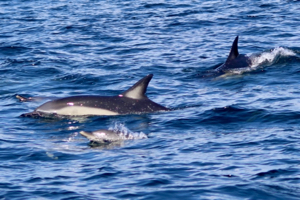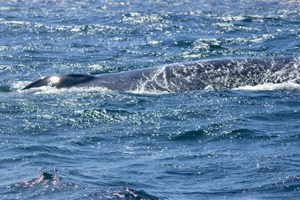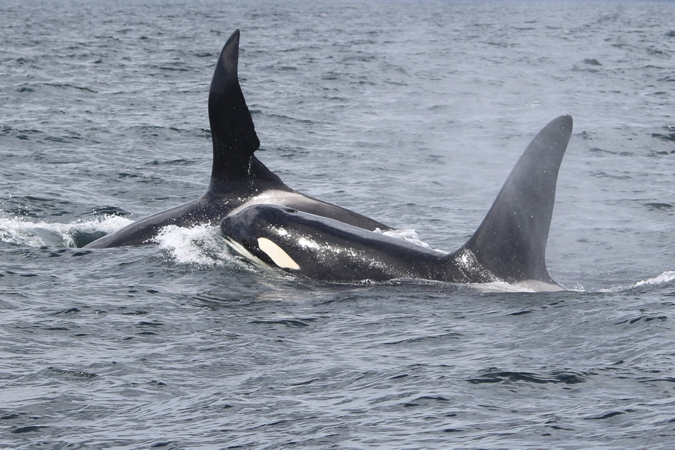I’ve just come back from a week spent down in West Cork with my family, and I must say I was really happy with how our holiday turned out! Thursday was easily the best day of the week as the weather was particularly pleasant and sunny, and we had booked to go whale watching with Cork Whale Watch. After two previous attempts to go whale watching that ended up being cancelled due to poor weather, we were finally lucky with our third attempt at the chance to experience seeing whales out at sea.
Having met our captain and the owner of Cork Whale Watch, Colin Barnes, we took the boat out from Union Hall, complete with rain gear, woollen hats, and our camera and binoculars for whatever we would see. We also didn’t forgot to bring water and snacks to keep us going. While we were still close to the land, we saw several grey seals swimming in the water and sunbathing on the rocks, just like what we saw from Baltimore back in June. Throughout the trip, we saw a variety of seabirds out on the open water, including herring gulls, guillemots, fulmars, Manx Shearwaters and storm petrels (the latter of which I don’t recount seeing before). We saw many different groups of these birds floating at the water surface.
By the time we were truly far from the land, a dark, slim, upwards-pointing dorsal fin caught my eye breaking the water’s surface to the left of the boat. Several minutes later, we saw our first ever whale, a Minke Whale, its dark back and relatively large dorsal fin breaking the surface. Everyone on the boat naturally went over to the part of the boat closest to where we spotted the whale, and I knew I didn’t want to miss the opportunity for a good photograph. Colin told us that there were two Minke Whales surrounding us, an adult and a juvenile, possibly a mum and calf. We saw the back of one of them again in front of the boat, giving a clear profile of its back and dorsal fin. I took a few photos of the whale with the camera, but they’re not that good, so I decided not to use them here. Seeing the Minkes was exciting enough, but this encounter was only the first of what was yet to come.

After a while of seeing nothing more than the different seabirds I mentioned, we eventually saw a pod of Common Dolphins, comprised of several adults and youngsters swimming towards us. I had seen Bottlenose Dolphins before both in the wild and in captivity in Portugal, but never before had I seen a Common Dolphin. The slim dorsal fin I mentioned earlier likely belongs to this species. We watched as the pod swam all around the boat and breaking the surface with their backs. The water in front of us was so clear, we could see the dolphins swimming underneath. It was also nice seeing the dolphins playing around us, leaping partly out of the water and landing on their sides. As the name suggests, Common Dolphins are the most populous species of cetacean in the world, and we saw several more dolphins over the course of the trip, which included during our encounter with an even more exciting species.

We were just about to head back towards the mainland having spent around two hours out at sea. Then we passed by another boat with whale watchers, with whom Colin had a brief conversation in which he mentioned detecting Fin Whales nearby. The Fin Whale was the animal I was most looking forward to seeing on the trip, being the 2nd largest animal in the world after the Blue Whale, and thus making it all the more spectacular to see. As we sailed further out to sea, we waited until we saw the whale’s spouts (a cloud of air exhaled through the animal’s blowhole) in the distance. Moving further up, we could see the back and dorsal fin of a fin whale breaking the surface after seeing its spout. I threw my fist in the air in a victorious manner, knowing that this was my first time seeing Earth’s second largest animal. After seeing their spouts followed by their long, grey backs, we saw not one, not two but three Fin Whales lunge-feeding at a school of fish rounded up by a pod of Common Dolphins. Colin explained that the dolphins corral the fish into a bait ball which the whales then take advantage of, and so the sight of a few dolphins being followed by a large wave could mean a Fin Whale preparing to feed. For much of the hour plus that we saw them, I made sure to take plenty of videos with my phone any time one or all of the whales exhaled and showed their backs to us. It was an absolutely memorable experience to have the Fin Whales around us, and I considered them an instant highlight.
But the experience was not over yet. As we headed back towards the mainland after enjoying the Fin Whales, Colin was contacted to inform him that two Killer Whales (or Orcas) had been spotted nearby. This was especially exciting as these were the first Orcas to be seen in these waters for four years, according to Colin. As we sailed in the direction they were found, we could see their huge dorsal fins breaking the surface from a long distance away, though Dad wasn’t initially sure what they were. As we got closer, the two Orcas, both male (as the females have a smaller dorsal fin), swam around us as they surfaced every minute or so, often showing the distinctive white patches behind their eyes. One of the Orcas had a notch at the base of its dorsal fin, which was also slightly bent over to the side. Just like with the Fin Whales, I took a bunch of videos of the Orcas when they made their appearance above the water surface. We watched the two for around an hour before it was time to head back towards the mainland. On our way back, I tried to decide whether the Fin Whales or the Orcas were the main highlight. I eventually decided on the Orcas, due to them being the first to be seen here for 4 years, with the Fin Whales a close second.

Overall, we spent more than six hours out at sea with the intent of seeing cetaceans, and it proved to be a truly productive day, with 4 species that we had never seen before: Minke Whale, Common Dolphin, Fin Whale, and Orca/Killer Whale, in that order. The Orcas were a really nice surprise since, unlike the other three species, they are rarely seen off West Cork. It’s also incredible to think that this day came not too long after I saw my first badgers last month, which had already helped to make my summer. Our day of whale watching is certainly a day that will stick with me for as long as I can remember!
Stay tuned for the next part of our Cork holiday, as I detail my experience of sleeping on Cape Clear Island for the weekend.
Note: After our whale watching trip, it turned out that the two orcas we saw on the trip were well-known males, John Coe and Aquarius, who are believed to be the last surviving members of the ‘West Coast community’ of orcas. Both orcas are considered to be very old; John Coe (who can be identified by the notch in his dorsal fin) is believed to be in his 60s, with Aquarius not being much younger. This has made our orca sighting even more special!

2 Responses
A Weekend on Cape Clear – David Twamley
[…] post is a continuation from my previous blog post documenting our amazing time going whale-watching, as immediately after I was about to embark on another exciting adventure in West […]
Orca (Killer whale) – David Twamley
[…] two orcas seen during my family’s whale watching trip in 2022, named John Coe and Aquarius, are both considered old for orcas and are believed to be the last […]